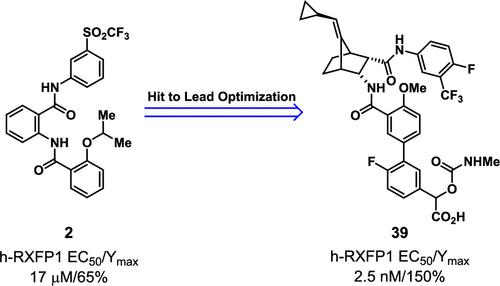The Discovery of C7-Substituted Norbornyl Bisamides as RXFP1 Small Molecule Agonists
IF 6.8
1区 医学
Q1 CHEMISTRY, MEDICINAL
引用次数: 0
Abstract
Human relaxin-2 (relaxin, H2-RLX, RLN2), an endogenous hormone associated with mammalian pregnancy, and its cognate receptor relaxin family peptide receptor 1 (RXFP1) have been implicated as important modulators of cardiovascular function and agonism of RXFP1 may potentially be utilized for the treatment of heart failure. Exploration of chemical space around previously reported anthranilamide 2 led to the discovery of lead compound 39 with significantly improved agonist activities toward human and rodent RXFP1. Compound 39 induced a dose-dependent heart rate increase in isoflurane-anesthetized naïve rats, which is consistent with the hemodynamic profile of relaxin in rat. Compound 39 also elicited significant interpubic ligament (IPL) expansion in C57BL/6 mouse, measured with microCT imaging, which recapitulated the effect of relaxin.

c7取代降冰片酰双酰胺类RXFP1小分子激动剂的发现
人类松弛素-2 (relaxin, H2-RLX, RLN2)是一种与哺乳动物妊娠相关的内源性激素,其同源受体松弛素家族肽受体1 (RXFP1)被认为是心血管功能的重要调节剂,RXFP1的激动作用可能被用于治疗心力衰竭。对先前报道的anthranilamide 2周围化学空间的探索导致先导化合物39的发现,其对人类和啮齿动物RXFP1的激动剂活性显着提高。化合物39诱导异氟醚麻醉naïve大鼠心率呈剂量依赖性增加,这与舒张素在大鼠体内的血流动力学特征一致。微ct成像显示,化合物39还能引起C57BL/6小鼠耻骨间韧带(IPL)明显扩张,再现松弛素的作用。
本文章由计算机程序翻译,如有差异,请以英文原文为准。
求助全文
约1分钟内获得全文
求助全文
来源期刊

Journal of Medicinal Chemistry
医学-医药化学
CiteScore
4.00
自引率
11.00%
发文量
804
审稿时长
1.9 months
期刊介绍:
The Journal of Medicinal Chemistry is a prestigious biweekly peer-reviewed publication that focuses on the multifaceted field of medicinal chemistry. Since its inception in 1959 as the Journal of Medicinal and Pharmaceutical Chemistry, it has evolved to become a cornerstone in the dissemination of research findings related to the design, synthesis, and development of therapeutic agents.
The Journal of Medicinal Chemistry is recognized for its significant impact in the scientific community, as evidenced by its 2022 impact factor of 7.3. This metric reflects the journal's influence and the importance of its content in shaping the future of drug discovery and development. The journal serves as a vital resource for chemists, pharmacologists, and other researchers interested in the molecular mechanisms of drug action and the optimization of therapeutic compounds.
 求助内容:
求助内容: 应助结果提醒方式:
应助结果提醒方式:


